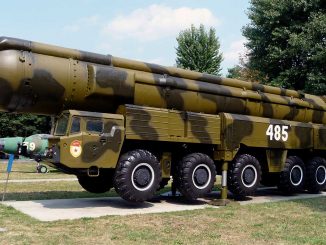« Threats in the cyber realm are an urgent national-security priority, as America has no equivalent to the two wide oceans that have helped safeguard our country’s physical, maritime, and aviation domains for centuries »
Remarks by Central Intelligence Agency Director John O. Brennan as prepared for delivery at the Council on Foreign Relations. Washington D.C. March 13, 2015. Source : CIA. ![]() See the full video below.
See the full video below.
Good afternoon everyone. Thank you, Charlie [Rose], for your introduction and for moderating today’s discussion. I also want to thank the Council on Foreign Relations and especially Richard [Haass] for inviting me to be here today.
Over the past many months, CIA has been in the news for a variety of reasons, most of them unrelated to the many challenges as well as the opportunities that lie ahead of us on the global stage.
So I would like to begin with a snapshot of some of the international developments and trends that are of greatest concern to the CIA and talk to you about how we are tackling these challenges. I thought I would take some time today to focus in particular on the importance of our work with foreign partners in enhancing global security. These relationships are founded on discretion, so we don’t talk about them much, but they play an essential role in our efforts to collect relevant and impactful intelligence, to provide insightful analysis, and to conduct effective covert action as directed by the President.
* * * *
Last month, an extremist gunned down a film director at a café in Copenhagen, made his way across town, and then shot and killed a security guard at a synagogue. Later the same day, the terrorist group ISIL released a video showing the horrific execution of Coptic Christians on a beach in Libya.
The previous month, in a span of less than 24 hours, we saw a savage attack on the staff of the satirical newspaper Charlie Hebdo in France; we saw a car bomb kill dozens at a police academy in Yemen; and we received reports that the extremist group Boko Haram had carried out yet another massacre in Nigeria claiming an untold number of innocent lives.
And in December, gunmen in Pakistan opened fire on school children in an attack that, even by the appalling standards of the Pakistani Taliban, was shocking in its moral depravity.
These attacks underscore a disturbing trend that we have been monitoring for some time: the emergence of a terrorist threat that is increasingly decentralized, difficult to track, and difficult to thwart.
While it is true that the United States and its allies have had considerable success degrading the capabilities of core al-Qa‘ida, various al-Qa‘ida affiliates and other terrorist organizations have surged in other countries. Countries such as Libya, Egypt, Somalia, Nigeria, and especially Yemen, where Al-Qa‘ida in the Arabian Peninsula has demonstrated a capability to plot attacks well beyond Yemen’s borders, including in our Homeland.
But no region has gained more of the world’s attention than Syria and Iraq, where ISIL is waging a campaign of unspeakable brutality against the local population, and indeed against anyone who does not share its ideology.
ISIL is well-armed and well-financed. Its fighters are disciplined, committed, and battle-hardened. Left unchecked, the group would pose a serious danger not only to Syria and Iraq, but to the wider region and beyond, including the threat of attacks in the homelands of the United States and our partners.
This will be a long-term struggle. ISIL will not be rolled back overnight. If there is one thing we have learned over the years, it is that success against terrorism requires patience and determination.
Clearly, our country will be dealing with terrorism in one form or another for many years to come.
What makes terrorism so difficult to fight is not just the ideology that fuels it, or the tactics that enable it. The power of modern communications also plays a role. New technologies can help groups like ISIL coordinate operations, attract new recruits, disseminate propaganda, and inspire sympathizers across the globe to act in their name.
The overall threat of terrorism is greatly amplified by today’s interconnected world, where an incident in one corner of the globe can instantly spark a reaction thousands of miles away; and where a lone extremist can go online and learn how to carry out an attack without ever leaving home.
Indeed, for all its advantages, the Information Age brings with it an array of new challenges that have profound implications for CIA’s mission—implications that go beyond counterterrorism.
The most obvious example, of course, is the tremendous growth of activities in the digital domain, which is full of tremendous opportunity for good but also serious challenges and vulnerabilities that can be exploited to harm our national security.
Threats in the cyber realm are an urgent national-security priority, as America has no equivalent to the two wide oceans that have helped safeguard our country’s physical, maritime, and aviation domains for centuries.
Every day, state actors, criminals, terrorist organizations, and hackers of all stripes try to penetrate our Nation’s digital networks. Government institutions are under constant assault, and private companies are spending enormous sums of money to defend against hacking attempts, denial of service attacks, and other efforts to disrupt their networks. The attack on Sony late last year was a reminder of just how serious the threat is and how quickly it can take place.
CIA is working with our partners across the federal government to strengthen cyber defenses, to share expertise, and to collaborate with the private sector to mitigate these threats. Together, we have advanced our understanding of threats in the cyber realm. But just as we have improved our knowledge as well as our capabilities, so too have our adversaries. They are skilled, agile, and determined, and matching them will require focus and imagination—not just from government, but from private industry as well.
In addition to counterterrorism and cyber security, developments in a host of countries across the globe are raising strategic and tactical challenges for policymakers and our Agency. Countries like Iraq, Syria, Yemen, Libya, Afghanistan, Pakistan, Ukraine, Somalia, Nigeria, Venezuela, and North Korea.
In addition to monitoring developments in these hotspots, our analysts track overall trends in global stability. Their findings for 2014 confirm the sense we all get from monitoring daily events that the current international environment is extraordinarily complex.
Developments last year continued a three-year trend of rising instability marked by severe conflict and the erosion of state capacity worldwide. We saw more outbreaks of instability than at any point since just after the collapse of the Soviet Union, matching the rate we saw during the period of decolonization in the 1960s.
The implications of this trend are well known to this audience. Rising instability leads to a growth in ungoverned spaces; a spike in humanitarian crises; a surge of refugees, weapons, and fighters across borders; and an emphasis on security over democratic principles among conflict-weary publics.
As CIA tackles these challenges, we benefit greatly from the network of relationships we maintain with intelligence services throughout the world. This is a critically important and lesser-known aspect of our efforts. I cannot overstate the value of these relationships to the Agency’s mission and to national security—indeed, to the collective security of America and its allies.
By sharing intelligence, analysis, and know-how with liaison services, we open windows on regions and issues that might otherwise be closed to us. And, when necessary, we act in concert to mitigate a common threat.
By collaborating with our partners, we are much better able to close key intelligence gaps on our toughest targets, as well as fulfill CIA’s mission to provide global coverage and to prevent surprises for our Nation’s leaders. There is no way we could be successful in carrying out a mission of such scope and complexity on our own.
Naturally, these are sensitive relationships built on mutual trust and confidentiality. Unauthorized disclosures in recent years by individuals who betrayed our country have created difficulties with liaison services that we have had to overcome.
But it is testament to the strength and effectiveness of these relationships that our partners remain eager to work with us. With the stakes so high for our peoples’ safety, these alliances are simply too crucial to be allowed to fail.
From the largest services with global reach to those of smaller nations focused more on local and regional issues, CIA has developed a range of working relationships with our counterparts overseas.
No issue highlights the importance of our international partnerships more right now than the challenge of foreign fighters entering and leaving the conflict in Syria and Iraq.
We roughly estimate that at least 20,000 fighters from more than 90 countries have gone to fight—several thousand of them from Western nations, including the United States. Blunting the danger these fighters pose upon their return is a top priority for the US Intelligence Community as well as our liaison partners.
We exchange information with our counterparts around the world to identify and track down men and women believed to be violent extremists. And because we have the wherewithal to maintain ties with so many national services, we act as a central repository of data and trends to advance the overall effort.
On this and innumerable other challenges, our cooperation with foreign liaison quietly achieves significant results. Working together, we have disrupted terrorist attacks and rolled back groups that plot them, intercepted transfers of dangerous weapons and technology, brought international criminals to justice, and shared vital intelligence and expertise on everything from the use of chemical armaments in Syria to the downing of a Malaysian airliner over Ukraine.
These relationships are an essential adjunct to diplomacy. And by working with some of these services in building their capabilities, we have helped them become better prepared to tackle the challenges that threaten us all.
CIA’s role in enhancing the capacity of our foreign partners is part of a team effort across our government. Just as the Defense Department helps train foreign militaries and the Justice Department assists in developing criminal justice systems, CIA works with many of our liaison services to build their skills, tradecraft, and technology.
To be sure, if we are to work with a broad range of services around the globe, we must also focus on enhancing professionalism and commitment to the ethics of intelligence. We advocate core principles and practices that are indispensable to any intelligence agency, like shunning involvement in the political process, maintaining strict independence and objectivity, and adhering to international norms.
With CIA’s support, I have seen counterparts develop into sophisticated and effective partners. Over time, our engagement with partner services fosters a deeper, more candid give-and-take, a more robust exchange of information and assessments, and a better understanding of the world that often ultimately encourages better alignment on policy.
Another advantage of building and maintaining strong bilateral and multilateral intelligence relationships is that they can remain—albeit not entirely—insulated from the ups and downs of diplomatic ties. These links can provide an important conduit for dispassionate dialogue during periods of tension, and for conveying the US perspective on contentious issues.
In recognition of the importance of our liaison relationships, I recently reestablished a senior position at the Agency dedicated to ensuring that we are managing relationships in an integrated fashion, to developing a strategic vision and corporate goals for our key partnerships, and to helping me carry out my statutory responsibility to coordinate the Intelligence Community’s foreign intelligence relationships.
This position is one of a number of changes underway at CIA designed to maximize our capabilities for the future. As you have read, last September I asked a group of very experienced officers from across CIA to take a fresh look at our organization and to make recommendations on how we can ensure that our Agency remains highly capable of carrying out our global mission in the years ahead. The result is the major initiative we announced last week.
That initiative stems from the two shifts in the national security landscape that I opened my remarks with today: The marked increase in the range, diversity, complexity, and immediacy of issues confronting policymakers, and the unprecedented pace and impact of technological developments.
Media attention has focused on our efforts to embrace and leverage the digital revolution by, among others things, creating a new Directorate of Digital Innovation. This step does not, as some have suggested, signify a marked change in CIA’s core mission. Rather, it an organizational response to the simple reality that, in today’s interconnected world, we must place our activities and operations in the digital domain at the very center of all our longstanding mission endeavors.
You also have read about the formation of Mission Centers. These are designed to better integrate our great strengths in collection, analysis, technology, and support, and apply them more efficiently and effectively to the Nation’s most pressing security issues and interests.
And finally, we are pushing ahead on two other strategic goals: doing a better job of attracting and developing a diverse and highly talented workforce, and modernizing the way we do business.
We seek to build a culture in which our people are intelligence officers first, regardless of whether they practice the discipline of analysis, collection, science and technology, digital innovation, or support.
And we want a business model that improves our capacity to make the sound strategic decisions needed to build a better Agency and run it efficiently, even as we respond to urgent external requirements. We are determined to push decisionmaking down deeper into the hierarchy, which is one reason we created the Mission Centers, the heads of which will hold considerable responsibility for taking initiative and further enhancing the agility that has always been crucial to our Agency’s success.
Before we begin our conversation, I would like to once again thank the Council for inviting me to speak here today. I am very proud of what my fellow CIA officers accomplish every day on behalf of our Nation, and I very much appreciate the opportunity to discuss our critical work—and, hopefully, to impart a better understanding of what we do and how we do it.
Thank you all very much.
Related Topic :










